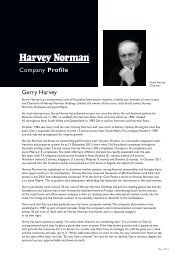annual report - Harvey Norman Company Reports & Announcements
annual report - Harvey Norman Company Reports & Announcements
annual report - Harvey Norman Company Reports & Announcements
Create successful ePaper yourself
Turn your PDF publications into a flip-book with our unique Google optimized e-Paper software.
STATEMENT OF SIGNIFICANT ACCOUNTING POLICIES (CONTINUED)<br />
(vii) Investment properties (continued)<br />
Investment Properties under Construction<br />
Investment properties under construction are valued at fair value if fair value can be reliably determined. The assessment<br />
of fair value may be based on an internal assessment conducted by the Board of the <strong>Company</strong> which may engage<br />
independent, qualified valuers to assist in the valuation process. The fair value of investment property under construction is<br />
calculated using the capitalisation method of valuation.<br />
Borrowing costs directly attributable to the acquisition, construction or production of qualifying assets, which are assets that<br />
necessarily take a substantial period of time to get ready for their intended use or sale, are added to the cost of those<br />
assets, until such time as the assets are substantially ready for their intended use or sale.<br />
(viii) Goodwill<br />
Goodwill on acquisition is initially measured at cost being the excess of the cost of the business combination over the<br />
acquirer‟s interest in the net fair value of the identifiable assets, liabilities and contingent liabilities recognised at the date of<br />
acquisition.<br />
Following initial recognition, goodwill is measured at cost less any accumulated impairment losses.<br />
Goodwill is not amortised. Goodwill is reviewed for impairment, <strong>annual</strong>ly or more frequently if events or changes in<br />
circumstances indicate that the carrying value may be impaired. As at acquisition date, any goodwill acquired is allocated<br />
to each of the cash-generating units expected to benefit from the combination‟s synergies. Impairment is determined by<br />
assessing the recoverable amount of the cash-generating unit to which the goodwill relates.<br />
Where the recoverable amount of the cash-generating unit is less than the carrying amount, an impairment loss is<br />
recognised. When goodwill forms part of a cash-generating unit and an operation within that unit is disposed of, the<br />
goodwill associated with the operation disposed of is included in the carrying amount of the operation when determining<br />
the gain or loss on disposal of the operation.<br />
Impairment losses recognised for goodwill are not subsequently reversed.<br />
(ix) Intangible assets<br />
Intangible assets, consisting of capitalised computer software assets and licence property, are initially recorded at cost and<br />
are amortised on a straight line basis over their estimated useful lives but not greater than a period of seven and a half (7.5)<br />
years.<br />
Intangible assets are tested for impairment where an indicator of impairment exists, either individually or at the cash<br />
generating unit level. Useful lives are also examined on an <strong>annual</strong> basis and adjustments, where applicable, are made on a<br />
prospective basis. The amortisation expense on intangible assets with finite lives is recognised in profit or loss in the expense<br />
category consistent with the function of the intangible asset.<br />
Gains or losses arising from derecognition of an intangible asset are measured as the difference between the net disposal<br />
proceeds and the carrying amount of the intangible asset and are recognised in the income statement when the<br />
intangible asset is derecognised.<br />
(x) Impairment of non-financial assets<br />
At each <strong>report</strong>ing date, the consolidated entity assesses whether there is any indication that an asset may be impaired.<br />
Where an indicator of impairment exists, the consolidated entity makes a formal estimate of recoverable amount. Where<br />
the carrying amount of an asset exceeds its recoverable amount the asset is considered impaired and is written down to its<br />
recoverable amount.<br />
Recoverable amount is the greater of fair value less costs to sell and value in use. It is determined for an individual asset,<br />
unless the asset‟s value in use cannot be estimated to be close to its fair value less costs to sell and it does not generate<br />
cash inflows that are largely independent of those from other assets or groups of assets, in which case, the recoverable<br />
amount is determined for the cash-generating unit (CGU) to which the asset belongs.<br />
In assessing value in use, the estimated future cash flows are discounted to their present value using a pre-tax discount rate<br />
that reflects current market assessments of the time value of money and the risks specific to the asset.<br />
In determining fair value less costs to sell, recent market transactions are taken into account, if available. If no such<br />
transactions can be identified, an appropriate valuation model is used. These calculations are corroborated by valuation<br />
multiples, quoted share prices for publicly traded subsidiaries or other available fair value indicators.<br />
61



